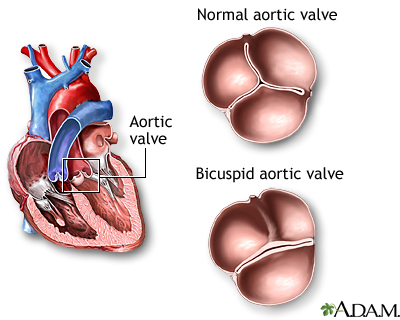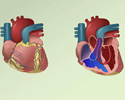Bicuspid aortic valve
Bicommissural aortic valve; Valvular disease - bicuspid aortic valve; BAV
A bicuspid aortic valve (BAV) is an aortic valve that only has 2 leaflets, instead of 3.
The aortic valve regulates blood flow from the heart into the aorta. The aorta is the major blood vessel that brings oxygen-rich blood to the body.
Causes
The aortic valve allows oxygen-rich blood to flow from the heart to the aorta. It prevents the blood from flowing back from the aorta into the heart when the pumping chamber relaxes.
BAV is present at birth (congenital). An abnormal aortic valve develops during the early weeks of pregnancy, when the baby's heart is developing. The cause of this problem is unclear, but it is the most common congenital heart defect . BAV often runs in families.
Congenital heart defect
Congenital heart disease (CHD) is a problem with the heart's structure and function that is present at birth.

A BAV may not be completely effective at stopping blood from leaking back into the heart. This leakage is called aortic regurgitation . The aortic valve may also become stiff and not open up. This is called aortic stenosis , which causes the heart to pump harder than usual to get blood through the valve. The aorta may become enlarged with this condition.
Aortic regurgitation
Aortic insufficiency is a heart valve disease in which the aortic valve does not close tightly. This allows blood to flow from the aorta (the larges...

Aortic stenosis
The aorta is the main artery that carries blood out of the heart to the rest of the body. Blood flows out of the heart and into the aorta through th...

BAV is more common among males than females.
A BAV often exists in babies with coarctation of the aorta (narrowing of the aorta). BAV is also seen in diseases in which there is a blockage to blood flow on the left side of the heart.
Coarctation of the aorta
The aorta carries blood from the heart to the vessels that supply the body with blood. If part of the aorta is narrowed, it is hard for blood to pas...

Symptoms
Most of the time, BAV is not diagnosed in infants or children because it causes no symptoms. However, the abnormal valve can leak or become narrow over time.
Symptoms of such complications may include:
- Baby or child tires easily
- Chest pain
- Difficulty breathing
-
Rapid and irregular heartbeat (
palpitations
)
Palpitations
Palpitations are feelings or sensations that your heart is pounding or racing. They can be felt in your chest, throat, or neck. You may:Have an unpl...
 ImageRead Article Now Book Mark Article
ImageRead Article Now Book Mark Article - Loss of consciousness (fainting)
- Pale skin
If a baby has other congenital heart problems, they may cause symptoms that will lead to the discovery of a BAV.
Exams and Tests
During an exam, the health care provider will likely find signs of a BAV including:
- Enlarged heart
-
Heart murmur
Heart murmur
A heart murmur is a blowing, whooshing, or rasping sound heard during a heartbeat. The sound is caused by turbulent (rough) blood flow through the h...
 ImageRead Article Now Book Mark Article
ImageRead Article Now Book Mark Article - Weak pulse in the wrists and ankles
Tests that may be ordered include:
-
MRI
, which provides a detailed image of the heart
MRI
A magnetic resonance imaging (MRI) scan is an imaging test that uses powerful magnets and radio waves to create pictures of the body. It does not us...
 ImageRead Article Now Book Mark Article
ImageRead Article Now Book Mark Article -
Echocardiogram
, which is an ultrasound that views the heart structures and blood flow inside the heart
Echocardiogram
An echocardiogram is a test that uses sound waves to create pictures of the heart. The picture and information it produces is more detailed than a s...
 ImageRead Article Now Book Mark Article
ImageRead Article Now Book Mark Article
If the provider suspects complications or additional heart defects, other tests may include:
-
Chest x-ray
Chest x-ray
A chest x-ray is an x-ray of the chest, lungs, heart, large arteries, ribs, and diaphragm.
 ImageRead Article Now Book Mark Article
ImageRead Article Now Book Mark Article -
Electrocardiogram (
ECG
), which measures the electrical activity of the heart
ECG
An electrocardiogram (ECG) is a test that records the electrical activity of the heart.
 ImageRead Article Now Book Mark Article
ImageRead Article Now Book Mark Article -
Cardiac catheterization
, a procedure in which a thin tube (catheter) is placed into the heart to see blood flow and take accurate measurements of blood pressure and oxygen levels
Cardiac catheterization
Cardiac catheterization involves passing a thin flexible tube (catheter) into the right or left side of the heart. The catheter is most often insert...
 ImageRead Article Now Book Mark Article
ImageRead Article Now Book Mark Article -
MRA
, an MRI that uses a dye to view the blood vessels of the heart
MRA
Magnetic resonance angiography (MRA) is an MRI exam of the blood vessels. Unlike traditional angiography that involves placing a tube (catheter) int...
Read Article Now Book Mark Article
Treatment
The infant or child may need surgery to repair or replace a leaky or narrowed valve, if complications are severe.
A narrowed valve can also be opened through cardiac catheterization. A fine tube (catheter) is directed to the heart and into the narrow opening of the aortic valve. A balloon attached to the end of the tube is inflated to make the opening of the valve larger.
Medicine may be needed to relieve symptoms or prevent complications. Medicines may include:
- Drugs that lower the workload on the heart (beta-blockers, ACE inhibitors)
- Drugs that make the heart muscle pump harder (inotropic agents)
- Water pills (diuretics)
Outlook (Prognosis)
How well the baby does depends on the presence and severity of complications of BAV.
The presence of other physical problems at birth also can affect how well a baby does.
Most babies with this condition have no symptoms, and the problem is not diagnosed until they are adults. Some people never find out that they have this problem.
Possible Complications
Complications of BAV include:
- Heart failure
- Leakage of blood through the valve back into the heart
- Narrowing of the valve's opening
- Infection of the heart muscle or aortic valve
When to Contact a Medical Professional
Call your child's provider if your baby:
- Has no appetite
- Has unusually pale or bluish skin
- Seems to tire easily
Prevention
BAV runs in families. If you know of this condition in your family, speak to your provider before becoming pregnant. There is no known way to prevent the condition.
References
Braverman AC. The bicuspid aortic valve and associated aortic disease. In: Otto CM, Bonow RO, eds. Valvular Heart Disease: A Companion to Braunwald's Heart Disease . 4th ed. Philadelphia, PA: Elsevier Saunders; 2014:chap 13.
Carabello BA. Valvular heart disease. In: Goldman L, Schafer AI, eds. Goldman's Cecil Medicine . 25th ed. Philadelphia, PA: Elsevier Saunders; 2016:chap 75.
Otto CM, Bonow RO. Valvular heart disease. In: Mann DL, Zipes DP, Libby P, Bonow RO, Braunwald E, eds. Braunwald's heart Disease: A Textbook of Cardiovascular Medicine . 10th ed. Philadelphia, PA: Elsevier Saunders; 2015:chap 63.
-
Congenital heart defect overview
Animation
-
Bicuspid aortic valve - illustration
A bicuspid aortic valve is an aortic valve that only has two leaflets, instead of three. The aortic valve allows oxygen-rich blood to flow from the heart to the aorta. It prevents the blood from flowing back from the aorta into the heart. An abnormal aortic valve develops during the early weeks of pregnancy, when the baby's heart develops.
Bicuspid aortic valve
illustration
-
Bicuspid aortic valve - illustration
A bicuspid aortic valve is an aortic valve that only has two leaflets, instead of three. The aortic valve allows oxygen-rich blood to flow from the heart to the aorta. It prevents the blood from flowing back from the aorta into the heart. An abnormal aortic valve develops during the early weeks of pregnancy, when the baby's heart develops.
Bicuspid aortic valve
illustration
Review Date: 5/6/2016
Reviewed By: Scott I. Aydin, MD, Assistant Professor of Pediatrics, Albert Einstein College of Medicine, Division of Pediatric Cardiology and Critical Care Medicine, The Children's Hospital at Montefiore, Bronx, NY. Review provided by VeriMed Healthcare Network. Also reviewed by David Zieve, MD, MHA, Isla Ogilvie, PhD, and the A.D.A.M. Editorial team.



